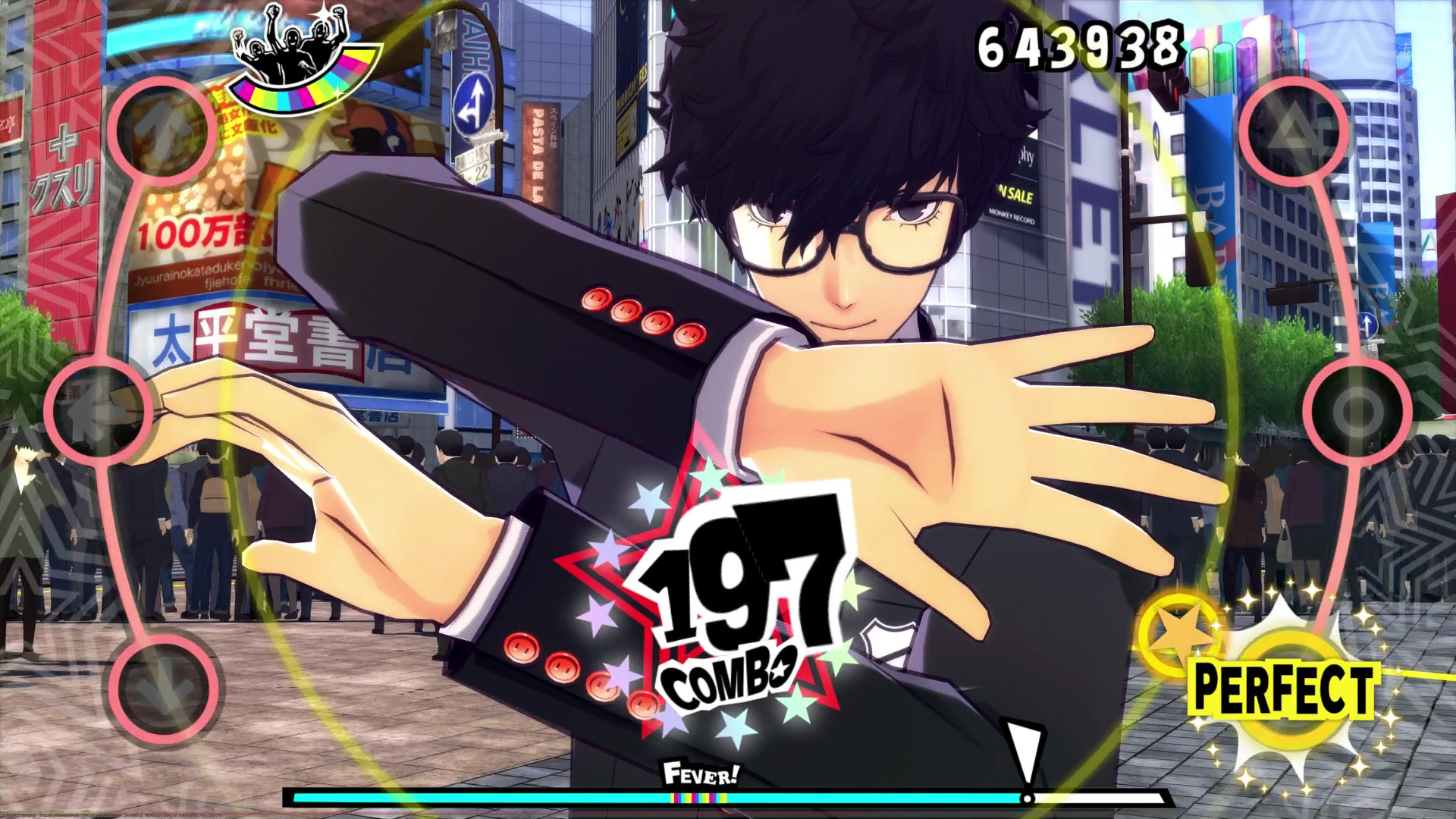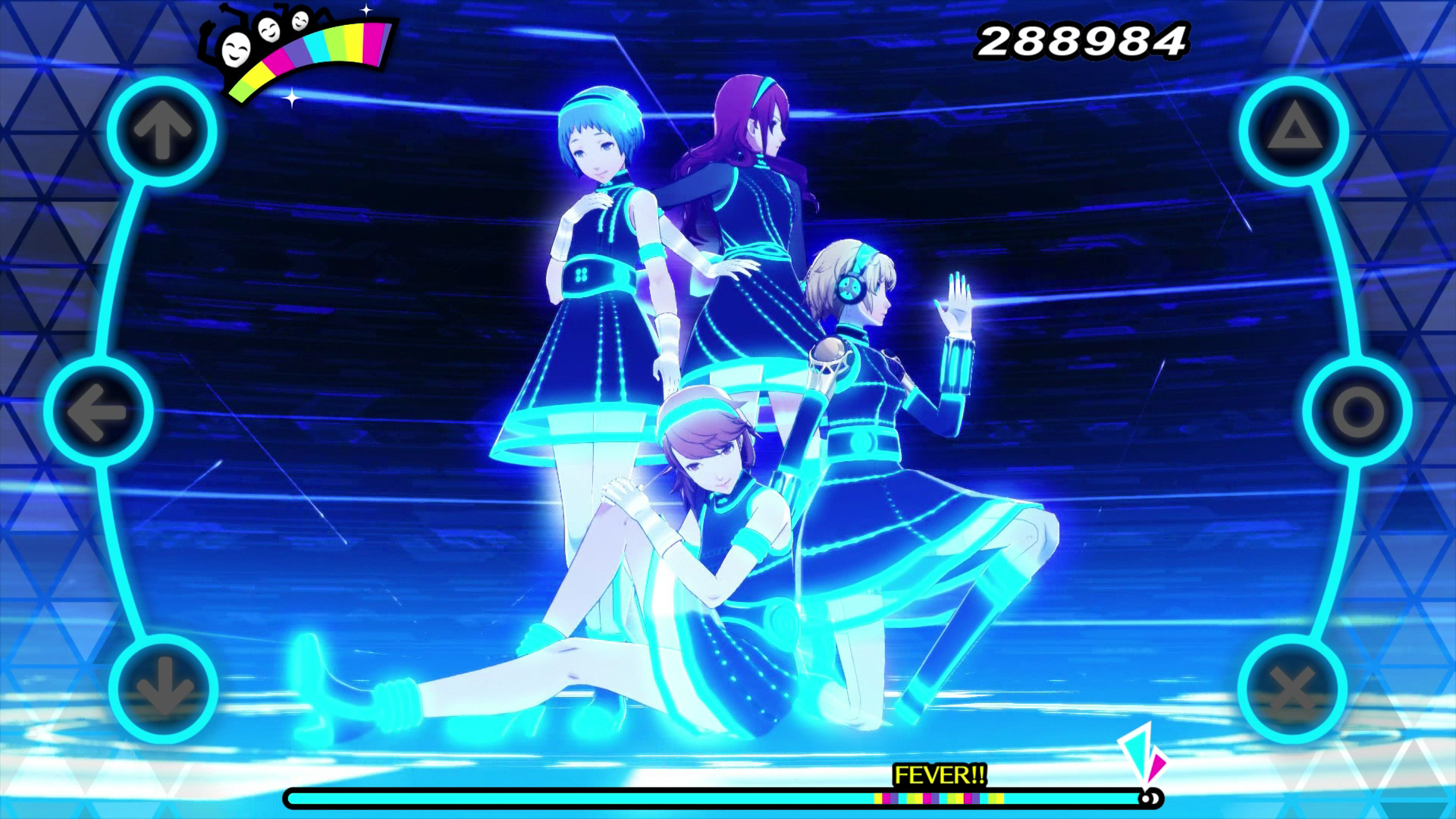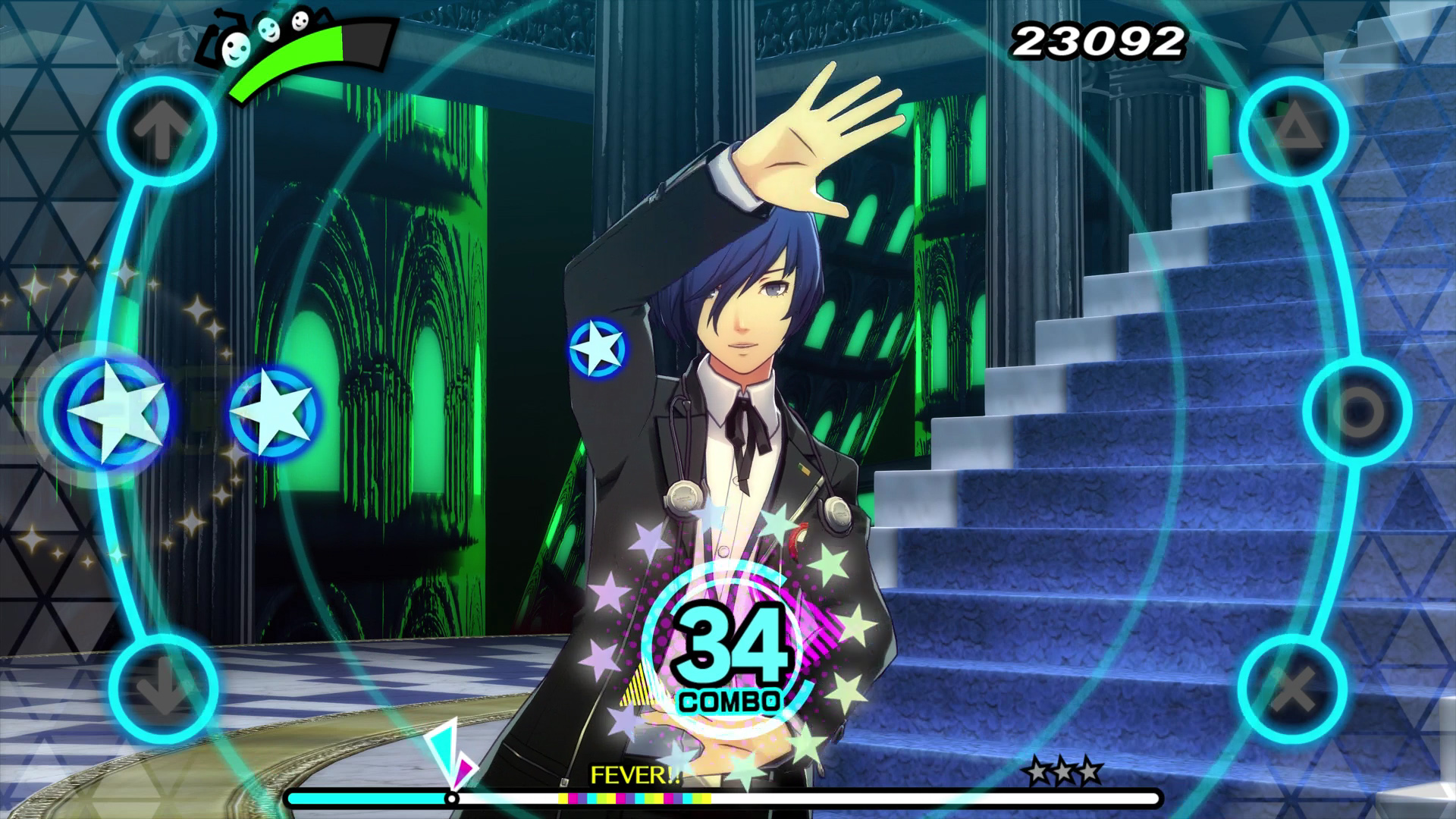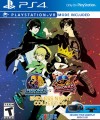I love rhythm games and I love Persona. Before the announcement of Persona 4: Dancing All Night in 2015 ever happened. It never occurred to me to combine these two things. Makes some sense though since Persona has always been a JRPG series. It wasn’t until Persona 4 characters were suddenly appearing in a fighting game, that the Persona series could span beyond just the JRPG genre. After that, Persona 4 became a rhythm game, which then became one of my all-time favorite games. Probably loved it as much as the original Persona 4 game too. So needless to say, I have a lot of love for a thing I never thought I wanted.
Coming off of that wonderful P4D experience. My mind certainly expanded to another Persona title, Persona 3. The music in that game was also very memorable to me and quite catchy. So I couldn’t help but wonder if we would ever see that get the rhythm game treatment. Nothing really happened and then Persona 5 saw release. It featured great music too. While playing Persona 5, I certainly had a thought in my mind of how awesome this music would be if it were playable like P4D was. So it only made my desire for another Persona rhythm game grow even more.
Then forward over to last year, where I was watching a livestream of the Persona Super Live concert. Enjoying the music I loved so much being performed. Then suddenly during an intermission, the lights went out and I suddenly see Persona 5 characters dancing on screen. I was quite ecstatic at what I was seeing because I immediately knew what it was. Then suddenly after that, there was Persona 3 characters dancing too. I was basically in tears at that point. So to basically summarize all of this, ever since P4D I’ve been wanting another Persona rhythm game and I was so happy when I found out we were getting two in the form of Persona 5: Dancing in Starlight and Persona 3: Dancing in Moonlight.

Before I dive further into this review, I should mention that I’ve actually already spent quite a lot of time in these games already when I imported the Japanese versions earlier this year. Obviously the big difference is with the audio dub and text being in a different language. For the most part though, the gameplay is the same. So I will be drawing in some of my experiences with that version along with the English releases.
So what exactly is Persona 3: Dancing in Moonlight and Persona 5: Dancing in Starlight? Basically it’s Persona 4: Dancing All Night, but themed around Persona 3 and Persona 5 this time. It’s a rhythm game that features the music and characters of the game it’s based on. Features these characters dancing it out in the background, while you try to focus on hitting the notes on the outer border of the screen in time with the music. The concept is simple, but once the notes start flowing on the screen, it can easily throw you for a loop.
THE GOOD: If you enjoyed Persona 4: Dancing All Night, then you probably will enjoy P3D and P5D also. It does help though to have some affinity with the original games the’re based off of. I loved Persona 3 and I loved Persona 5. So I immediately fell into that groove that I felt with P4D and just got addicted to the games. The gameplay is pretty much identical. Can be seen as bad in some way too, since these games are kind of like a sequel. I didn’t mind it much though since I’ve gotten used to that playstyle and it’s nothing really new for rhythm games. Think along the lines of the Project DIVA titles. You got multiple installments of those game without too much evolution in the gameplay.
It’s not all the same though. These games are not only Vita releases like P4D was. These are PS4 games now and that system leap brought in a big benefit over the original P4D. That being a smoother framerate from 30fps to 60fps. I had no real trouble with P4D on Vita, but I do feel that the increased framerate makes these games feel more in-sync with itself. Like, I feel it’s more accurate with my inputs.
The Fever Time sequences have also changed up a bit. Back in P4D, when you hit Fever Time with the gauge in the green area, the chosen dance partner would appear alongside the main dancer. That’s no longer the case for P3D and P5D. As long as you trigger Fever Time, the chosen dance partner will appear. No matter how bad you’re doing at the song during that time. Even further, instead of only being tied to one dance partner, you can now have up to two partners. One for each Fever Time sequence if that particular song has it. So there’s a bit more customization there now with the dance partners.

Overall the customization just seems better. Or at the very least, feels like there’s more to it. You’re able to change lots of custom parts for each character. Add on glasses, change the outfit, add in extra accessories on top of that, and change the hat being worn. You can really mix it up this time around. A good amount of these items are available too, which you will unlock as you play the game.
Speaking of which, the set-up of these games is much different from P4D. No story mode present or in-game store where you spend currency to unlock items. Instead, you get Social events. They act like Social Links in some ways and you unlock ranks by completing certain objectives. Each character from the P5 and P3 cast is featured and each one has their own set of objectives you’ll need to fulfill. Things like earning good ratings on songs or using different outfits for each dance. Completing these Social events will then reward you with various customization items. Along with some fun interactions and conversations among the varied cast of characters. The character models during these Social events look good too and are nicely animated. They feature fully animated 3D models instead of static 2D images. Fully voiced lines too by the returning cast that you remember from previous games.
THE BAD: There’s a lot of good things to be found, especially if you really enjoyed P4D. The overall experience just feels improved in many ways. There are a few things to be disappointed by though. It doesn’t really have to do with the gameplay of the game, as I find that to be completely solid. However, there are certain things around that gameplay that are questionable to me.
For one, the dance videos themselves seem less flashy when compared to the stuff P4D had. In these new games, there seems to be a larger focus on the dancer and not so much switching the camera around and putting up some neat effects in the background. As someone who doesn’t focus on the background that much, it’s a minor issue. Though, it is a bit disappointing when compared to P4D that not much activity is going on in the background other than just the dancer dancing. So that is actually something P4D has the upper hand on in terms of presentation.
The lack of story mode is also a bit of a bummer. Would have been nice to see some sort of continuation with these cast of characters. However, I am aware how complicated that may be when dealing with Persona 3. I do like the Social Link type events that are in the game though, and it nicely shows off the character models and it’s fully voiced. The requirements for unlocking these events though can be a bit grindy, and for certain objectives, it can be slightly difficult to keep track of your overall progress. It does help add playtime to the game, and if you already enjoy playing it and customizing the dancers, it won’t take too long to unlock all the events.
Also, since we are dealing with a game centered around music. You can expect to find certain tracks that are less pleasing to your tastes. This does apply here since there are various kinds of remixes of Persona tracks here along with several one from their original games. Not to mention that the overall types of music found in Persona 3 and Persona 5 are quite different. So obviously not everything will be a hit depending on your tastes. For me, I would probably choose P3D as the winner here in terms of music quality. Although, I still enjoy both games.
Perhaps the biggest disappointment for me though is the amount of song content in the game. If we don’t count DLC, there is 25 songs each for P3D and P5D. In P4D, you had 27 songs. Now when we do look at the DLC content, in total there are an additional 36 songs. A few were free in the JP version of the game, but it looks like all DLC songs will need to be paid for in the English release. When you see that these are full priced games at $59.99, it will certainly add up if you were to invest in obtaining all the songs. Possibly even doubling the price of the actual game too depending on what you choose to purchase. The songs themselves are fun to play, but they could’ve easily been in the game from the beginning or even free. Only a few songs feature a new character in them, with the rest being compilation videos from the anime show and game openings. Even the full version of the new theme songs aren’t even included in the game and must be purchased.
So while I do find the gameplay very fun. I just wish I had more there to play it with, and at a more reasonable price. I mean, when you compare the Persona Dancing series to the Project DIVA series, which is another rhythm franchise that’s part of SEGA. It’s very odd how that series is able to have a sizable amount of content for a normal or budget priced game, but the Persona games offer you much less for a higher price. It certainly feels like the fanbase is being taken advantaged of by having a lot of content for the game be behind a paywall. This doesn’t only apply to the songs either, as lots of additional costumes and accessories are also available as priced DLC. So while I love this game very much, it’s certainly not the most valuable of game investments. I will at least say though that the pricing structure for the western release is at least cheaper than what the JP version had. There’s a lot of DLC for this game, and Atlus USA decided to bundle them up into Season Pass bundles that are decently priced. At the very least, if you choose to invest in all the DLC for this game, it is at a much cheaper cost than how it was done in Japan. So as someone who was already planning on buying all the DLC and dreading the costs, I’m very thankful that it came out much cheaper than I had anticipated.

OVERALL THOUGHTS: I loved Persona 4: Dancing All Night and that love has easily transitioned to Persona 3: Dancing in Moonlight and Persona 5: Dancing in Starlight. The songs and remixes featured are fantastic to listen to and to play to. I just find the gameplay, the difficulty, the music, and the overall presentation, to be just the perfect blend for me in terms of rhythm games. There have been changes made since P4D, some good and some bad. Exchanging a story mode for more direct character interactions. Also upping the choreography and amount of dancers present, but lessening the MV effects. However, the gameplay is basically unchanged and I find it still as fun and satisfying as ever. There is still that lacking of overall song content for the price that I did feel for P4D, and it is actually worse in P3D and P5D. That will certainly be a problem for many who are perhaps not as invested in the entire Persona brand. Personally for me, I just love the gameplay so much that I need to play all of it. So while it’s not the most valuable of purchases, I am certainly looking forward to the new DLC content.
Even with that said, I would still recommend these games. It definitely helps if you’re a Persona fan though. As rhythm games, they are fun too. I just feel like if the music doesn’t resonate that much to you, it could certainly be a hard sell. Also, the gameplay is very friendly on the easier difficulties, so Persona fans who aren’t as adept at rhythm games can still make progress through the game. If you’ve enjoyed P4D, then I easily recommend you check these new games out too. It still remains one of my favorite rhythm franchises and I hope they continue to do more of them.
As a final note, if you are interested in the games and looking for some value, I would highly recommend getting the Persona Dancing: Endless Dance Collection. It’s a PS4 bundle that includes P3D and P5D together, along with a digital PS4 version of P4D, for the price of $99.99. That’s $10 off each game and it comes with the only way you can obtain the PS4 version of P4D for no additional price. Also, I kind of actually do feel like they really should’ve combined P3D and P5D into one game. So this bundle feels like a more complete purchase in a way than if you were getting them all separately.
*A PS4 digital copy of these games was provided by ATLUS USA for review purposes.














You must be logged in to post a comment.